If you are a first time visitor to Athens you probably wonder how many days to spend in the city, or if it’s even worth visiting. Most people land in Athens on their way to other destinations in Greece, so they don’t plan to spend more than a day or two here, at the most. Would that be enough for visiting this historic city?
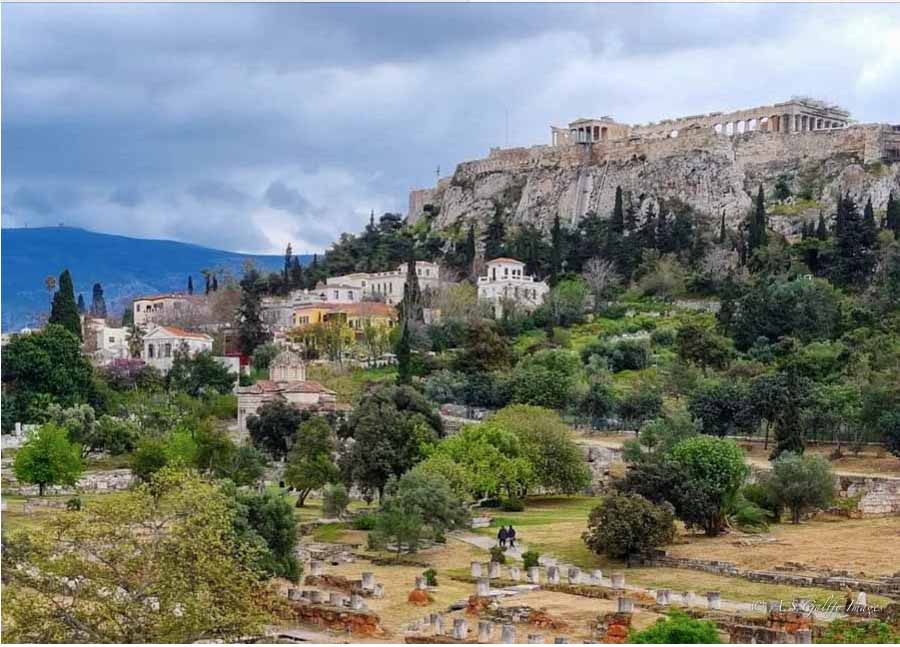
Before we get into more details about how many days you’ll need in Athens, let’s first discuss what to expect when visiting the Greek capital.
Table of Contents
- Is Athens Worth Visiting?
- How Many Days to Spend in Athens
- How to Get Around in Athens
- Where to Stay in Athens
- How to Save Time & Money in 3 Days in Athens
- What to Visit in Athens – a 3-Day Itinerary
- 1. The Acropolis
- 2. Acropolis Museum
- 3. Ancient Agora & Temple of Hephaestus
- 4. Roman Agora
- 5. Hadrian’s Library
- 6. Temple of Olympian Zeus
- 7. Hadrian’s Arch
- 8. Athens National Archeological Museum
- 9. Karameikos Cemetery
- 10. Lycabettus Hill
- 11. Panathenaic Stadium
- 12. Plaka & Anafiotika Neighborhoods
- 13. Monastiráki Square
- 14. Church of Panagia Kapnikarea
- More Than 3 Days in Athens?
Is Athens Worth Visiting?
For those who love history Athens doesn’t need much introduction. The city is not only Europe’s oldest capital, but also one of the oldest continuously inhabited cities on earth. It’s the cradle of western civilization and the place where democracy and philosophy were born. It’s also the birthplace of the Greek drama.
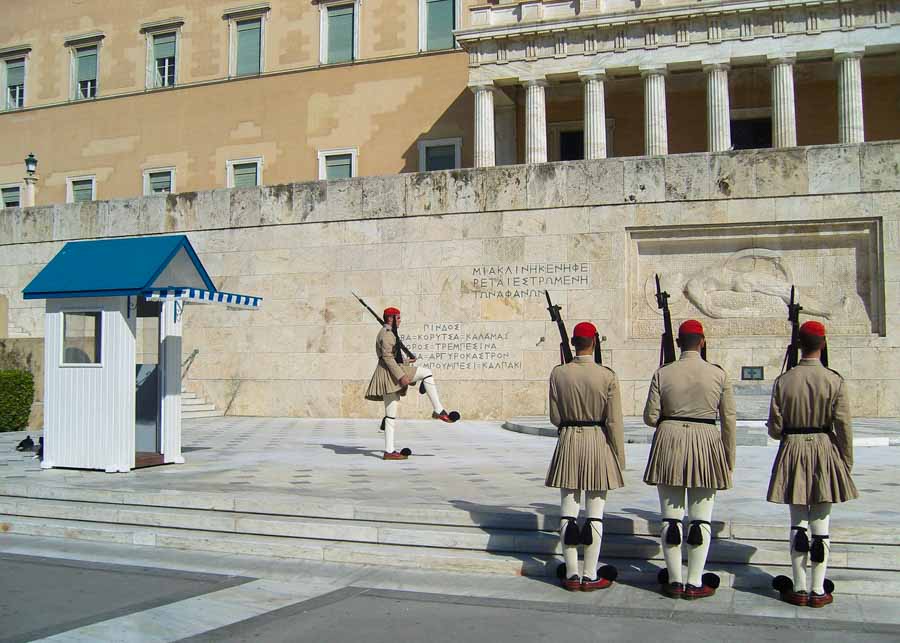
As you may expect, with over 3000 years of history Athens is a city imbued with culture and loaded with ancient ruins and fascinating museums. So if that’s what you are after, you won’t be disappointed.
Modern Athens, on the other hand, is a mixed bag. A city of extraordinary contrasts. On one side you have the towering, magnificent Parthenon and the Acropolis, while on the other you see a sprawl of ugly concrete apartment blocks.
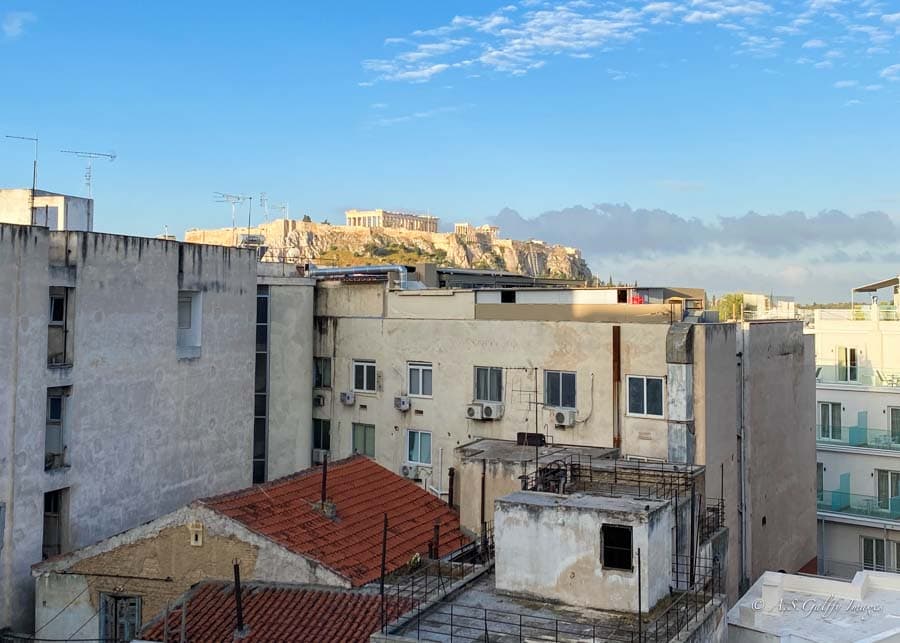
Except for a few nice neighborhoods like Plaka, Monastiraki, or Syntagma Square, Athens looks more like a battleground of old versus new. It has neither the classical elegance or grandeur of an ancient city, nor the splendor of other European capitals, like Rome or Paris. Almost everywhere you turn you’ll see ugly, nondescript buildings standing next to run-down neoclassical ones, construction sites and wire fencing.
Why does Athens looks so weird? The answer is not simple as there are many factors that contributed to this aspect. After gaining its independence, Greece went through very hard times. People rushed to the big cities to make more money, so urbanization happened very fast.
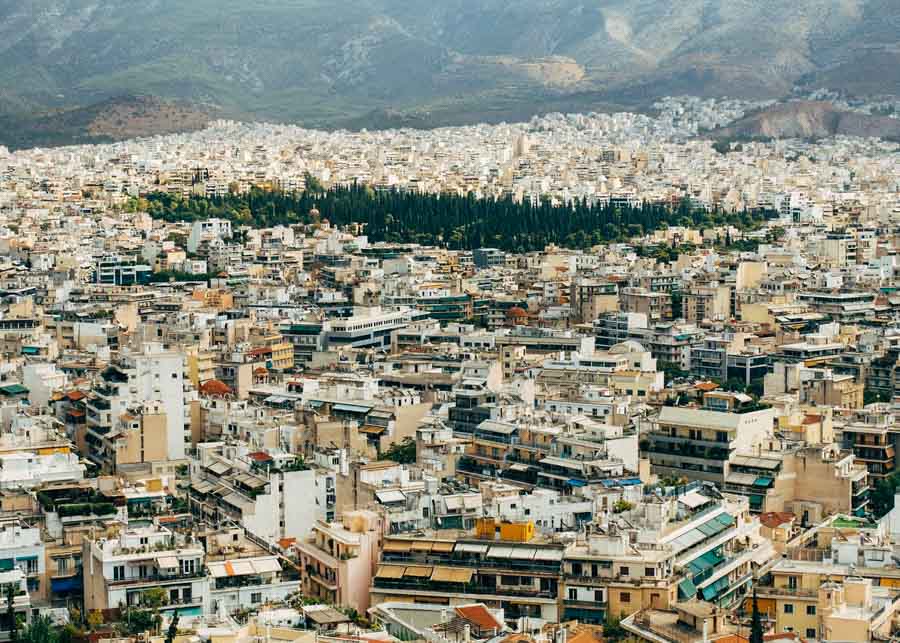
This caused anarchy in the construction industry. Houses started popping up with no urban planning whatsoever. The result is the sprawl of ugly structures that you see today. And not only in Athens, but in most big cities in Greece as well.
The Food Scene
In contrast with other European capitals where international cuisine is pretty much the norm, the food scene in Athens has very little diversity. Greeks seem to be very content with their own food and are not interested in trying other cuisines.

As far as I am concerned, I LOVE Greek food and couldn’t get enough of it! But if you want more variety or you are looking for some specific cuisine, you won’t find it in Athens.
The People
What makes Athens a magic place to visit are not the sites, the architecture, or the restaurants, but the people. Their joy of life, kindness and spontaneity takes over the chaotic vibes of the city. Greek hospitality is warm and genuine, with no hidden motive to gain anything other than perhaps some conversation.
How Many Days to Spend in Athens
Planning how long to stay in Athens depends on what your interests are, and whether you want to use the city as a home base for exploring the area around. The general rule is that larger European cities require 2-4 full days, while smaller cities only require 1-2 full days.
Are 2 Days in Athens Enough?
Athens demands a minimum of 2 days. If you walk fast enough and don’t plan to spend too much time at each attraction you may be able to visit the city’s most important sites in just two days. However, that won’t give you enough time for the museums, which is a pity since Athens has quite a few amazing ones!
How About 3 Days in Athens?
I think 3 days would be just the right amount of time to visit Athens without rushing. Although most points of interest are located in the historic district and thus easy to reach, there is some walking and step climbing involved.
We basically needed only 3 days for visiting the archeological sites, the main museums, and get a glimpse of the city’s most popular neighborhoods. We spent a total of 4 days in Athens, but that included a day trip to Delphi.
Are 4 Days in Athens too Long?
Obviously, the more time you have the more you’ll be able to immerse yourself in the local culture and explore some of the attractions that are outside the historic center. With 4 days you’ll be able to take a day trip from Athens, if you choose to. There are many options around, like Delphi archeological site, Corinth, or Cape Sounion.
How to Get Around in Athens
Walking
If you plan to spend 2-3 days in Athens, the best way to get around is on foot, as most of the city’s attractions are located in the historic center. We visited Athens independently, but you can also book a tour for one or more of the attractions.
Public Transportation
Athen’s metro is clean, efficient and inexpensive. However, I would only recommend using if you need to go to places that are outside of the historic center, like Lycabettus Hill or the port of Piraeus. And if you do, you’ll have to watch your pockets like nowhere else in Europe since petty crime in very high in Athens. Sadly, I’m talking from experience!
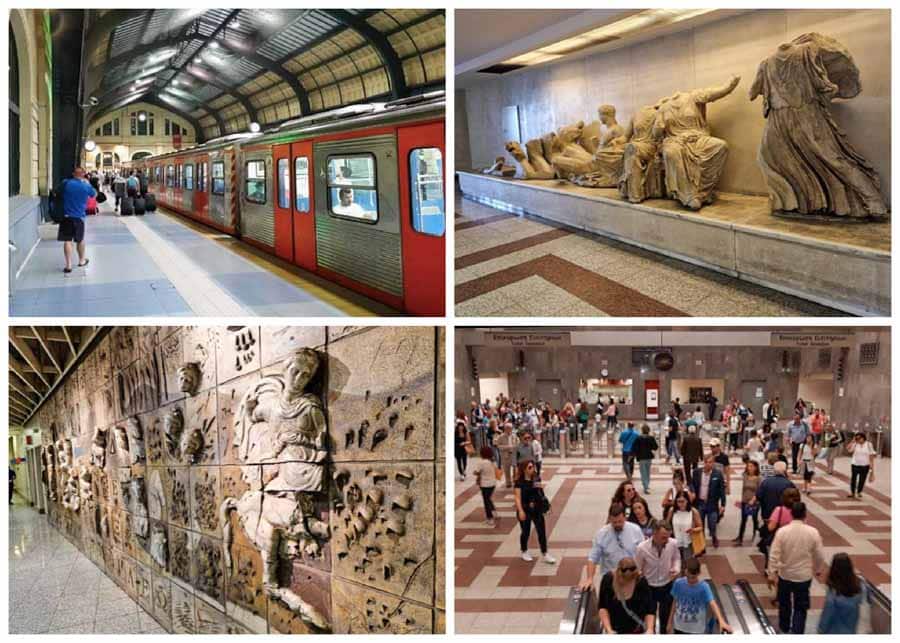
Taxis
We also found Taxis to be a good way to get around the Greek capital, as they are plenty and relatively inexpensive. During our 3 days in Athens we used taxis on several occasions and found them to be very convenient and reliable. The average taxi ride costs around $7.00, with the minimum fare starting at $1.50 plus $0.80/km in the city center and $1.40/km in the surroundings.
The Hop-on Hop-off Bus
The Hop-on-Hop-off Bus is a good alternative to walking between the attractions. There are different routes in Athens and different time durations (from 1 to 3 days) to choose from.

The open-top, double-decker bus takes you to the many important sights and attractions of the city and you have the option to get off the bus (and back on) wherever you choose to. Take the option to visit Piraeus too, as the port is farther away from the center.
Bus Tours We Recommend
Renting a Car in Athens
We rented a car at Athens Airport because our Greece itinerary also included a road trip in the Peloponnese. However, I don’t recommend driving in Athens as traffic is heavy and parking is expensive and hard to find. We had the car parked for 3 days while we visited Athens and paid almost $100 in parking fees!
Where to Stay in Athens
Whether you spend 1, 2 or 3 days in Athens, make sure to stay in one of the central areas such as Syntagma, Plaka, Monastiraki, or Thissio. All these neighborhoods are close to the places of interest in Athens and have good public transportation connections.
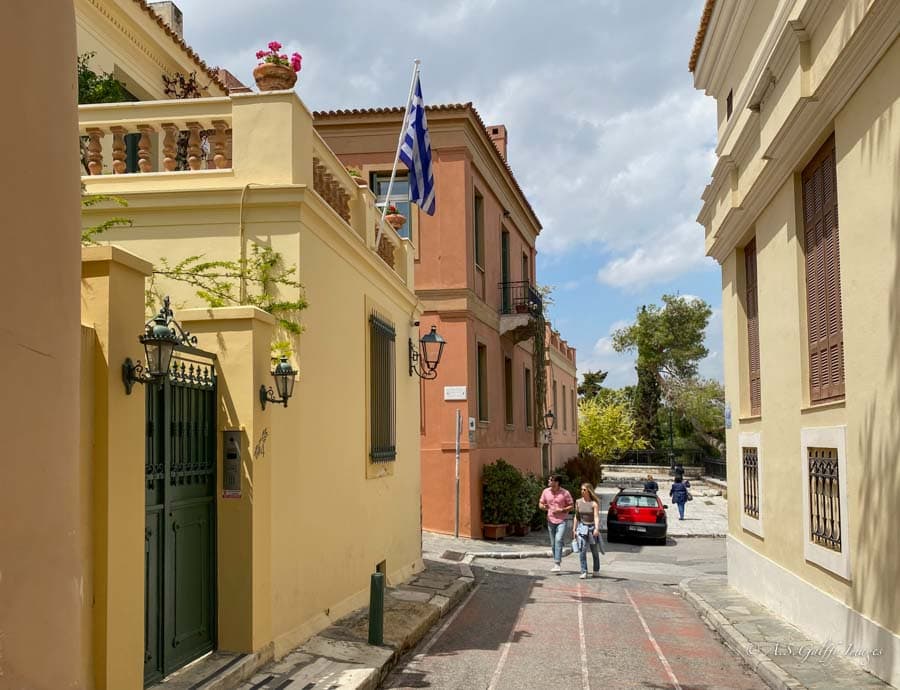
A good location in Athens makes a big difference not only on convenience but also on how much you’ll be able to see.
The best place to stay in Athens in our opinion is near the Acropolis. This includes the neighborhoods of Plaka, Syntagma Square, and Monastiraki. These areas are nicer that other parts of Athens, but most importantly, if you stay here you’ll be within walking distance of the Acropolis, Roman Agora, Library of Hadrian, and other places of interest in Athens.
- Best 5-Star Hotel in Athens: Hotel Grand Bretagne
- Best mid-range Hotel in Athens: Herodion Hotel
- Best Budget Hotel in Athens: Phaedra Hotel
- Our recommendation: Astor Hotel (clean, centrally located, views of the Acropolis from many rooms, rooftop terrace, reasonably priced)
How to Save Time & Money in 3 Days in Athens
Archeological sites are relatively expensive in Athens, so if you are planning to visit them (and you should!), the best option to save is the Athens Combo Ticket. This ticket gives you access to 7 archeological sites: Acropolis, Ancient Agora, Roman Agora, Theatre of Dionysus, Kerameikos Cemetery, Temple of Olympian Zeus, and Hadrian’s Library.
The combo ticket gives you one-time admission to each site and 4 self-guided audio tours in English (if you select the option). The cost is €30 for adults and €15 for students. Pre-booking a combo ticket will save you not only money, but also time as you’ll be skipping the long lines at Athens’ top sites.
READ NEXT: Greece in October – Best Beach Destinations to Visit in Fall
What to Visit in Athens – a 3-Day Itinerary
Here are our recommendations for the best places to visit in Athens in 3 days.
1. The Acropolis
High above the city, on a rocky outcrop, lies Athen’s most famous landmark – the Acropolis – a UNESCO world heritage site. In Ancient Greece the Acropolis of Athens was known as Cecropia, after the legendary serpent-man, Cecrops, the founder and first king of Athens.
This citadel contains the remains of several ancient buildings of great architectural and historical importance.
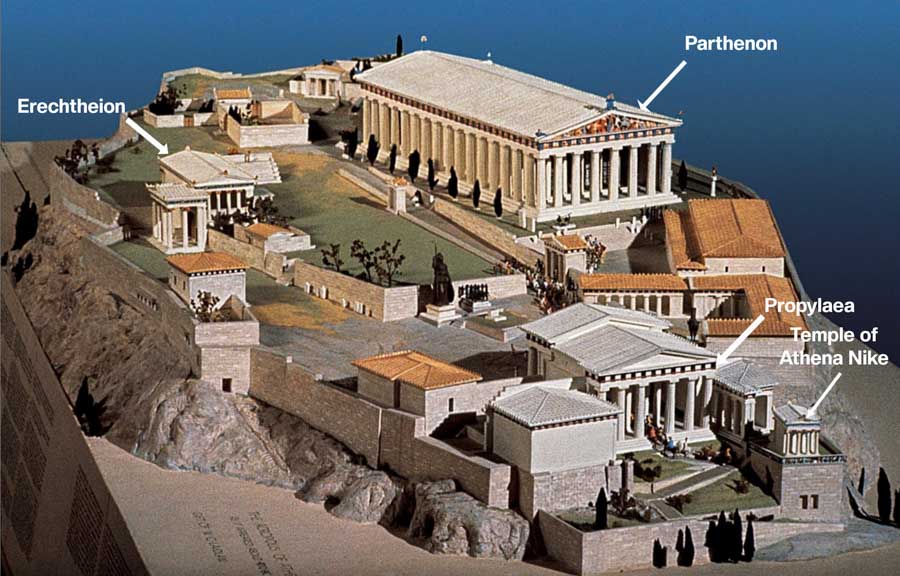
The Parthenon
The most recognizable building on the Acropolis is the Parthenon, which was built on top of a former temple destroyed by the Persians during the Greco-Persian Wars. The construction of the marble temple that you see today began in 447 B.C. The temple was dedicated to the goddess Athena.
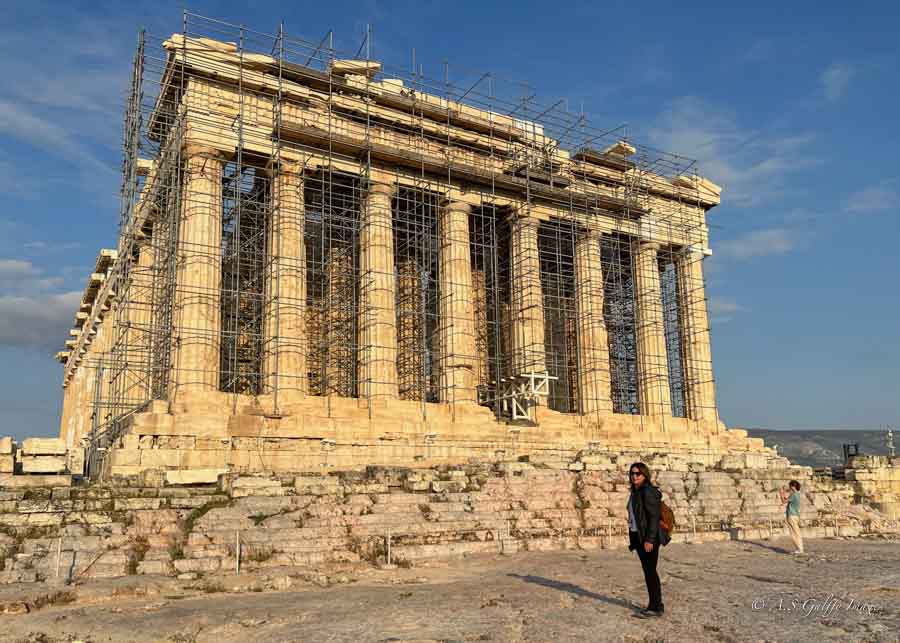
Erechtheion
On the north side of the Acropolis you’ll see the building of the Erechtheion, which was primarily dedicated to the goddess Athena. While the Parthenon is the most impressive temple on the Acropolis, the Erechteion was actually the building that housed the statue of Athena.
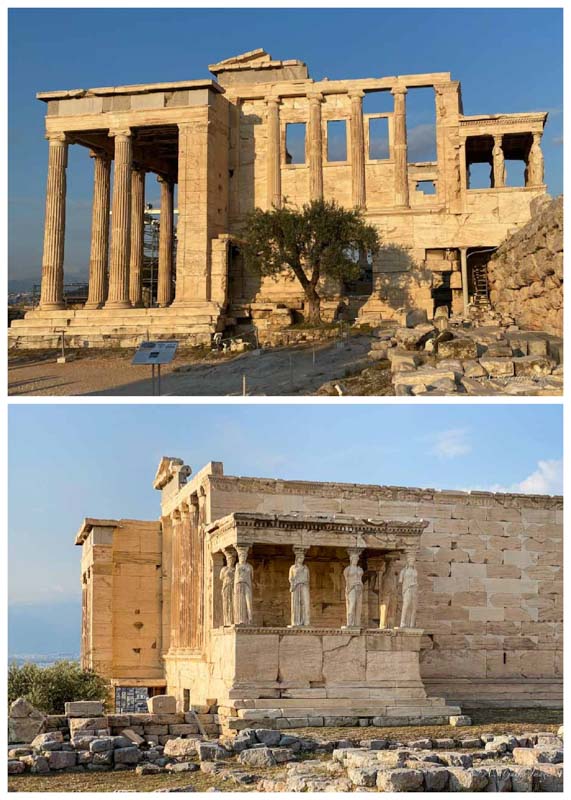
The temple has two porches: one at the northwest corner, which is supported by tall Ionic columns, and another at the south-west corner, supported by six massive female statues. These are the famous Caryatids which seem to carry the weight of the roof on their heads.
Propylaea
Propylaea (or Propylaia) is the classical Greek Doric building complex that you’ll come across after climbing the steps up the Acropolis. This structure functioned as the ceremonial gateway to the Acropolis of Athens, so no wonder it’s so monumental!
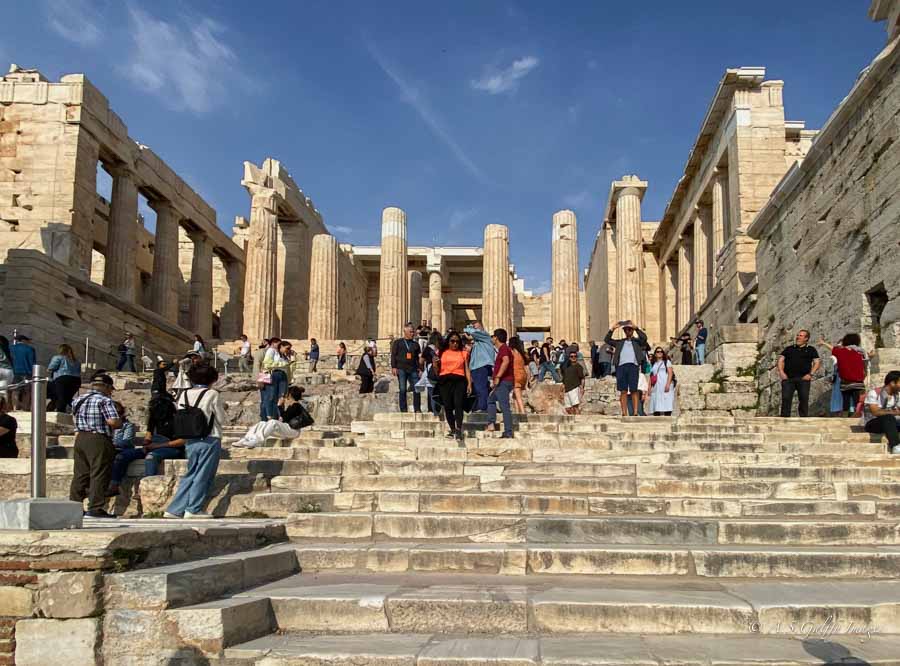
Temple of Athena Nike
To the right of the Propylaea, as you come up the stairs, you’ll see the small Temple of Athena Nike, which was completed around 420 BC. This is the smallest temple at the Acropolis.
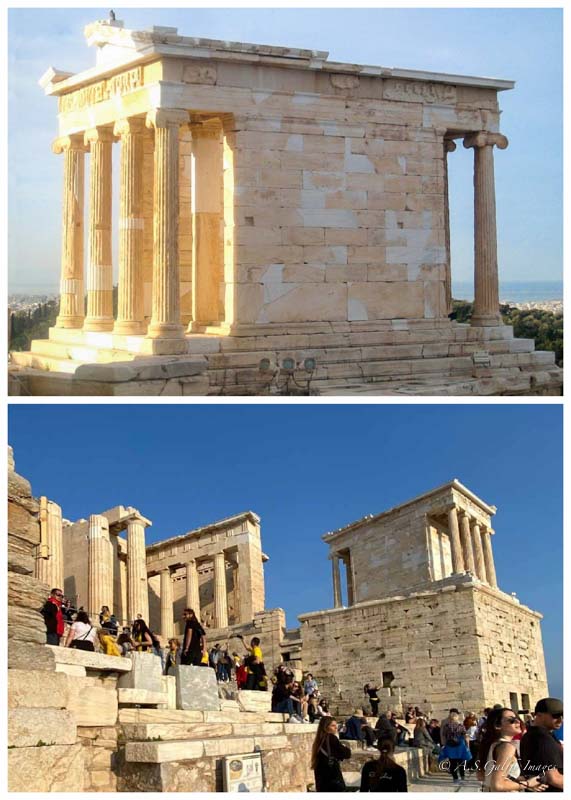
There is some archaeological evidence indicating that the temple was used for religious rituals since the Mycenaean period.
Herodium
Just beneath the slopes of the Acropolis sits the Odeon of Herodes Atticus, also known as Herodeon, or Herodium. This beautiful open-air theater was built between 160AD – 174AD by a wealthy benefactor of Athens –Herodes Atticus– as homage to his late wife Rigilla.
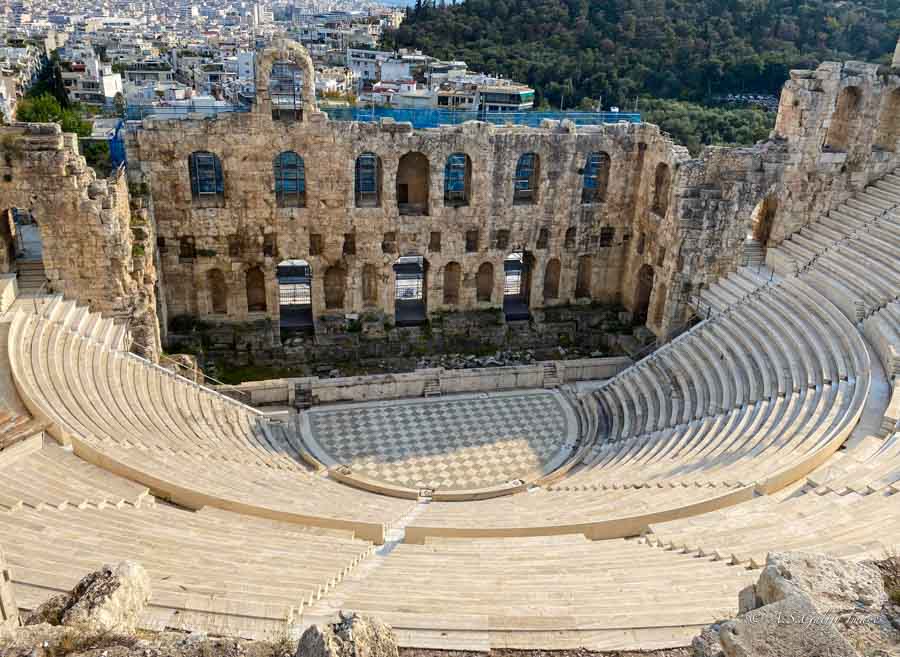
Today this ancient theater houses the Athens Festival, musical concerts and classical tragedies.
Practical Information for visiting the Acropolis
The Acropolis of Athens is open daily from 8 am to 8 pm in summer (April to October) and from 8 am to 5 pm in winter (November to March).
Admission is €24 for adults and €18 for children 17 and under. Admission is free for the European Union children age 18 and under. The site is included in the Athens Combo Ticket.
Tours We Recommend
2. Acropolis Museum
Just a few hundred meters below the Acropolis hill you’ll find the Acropolis Museum. The museum houses every artifact found on the Acropolis hill and the surrounding slopes. There are over 4000 exhibits and a lot to admire inside the museum. The highlights include the “Slope of the Acropolis” ramp and the statues on the first floor.
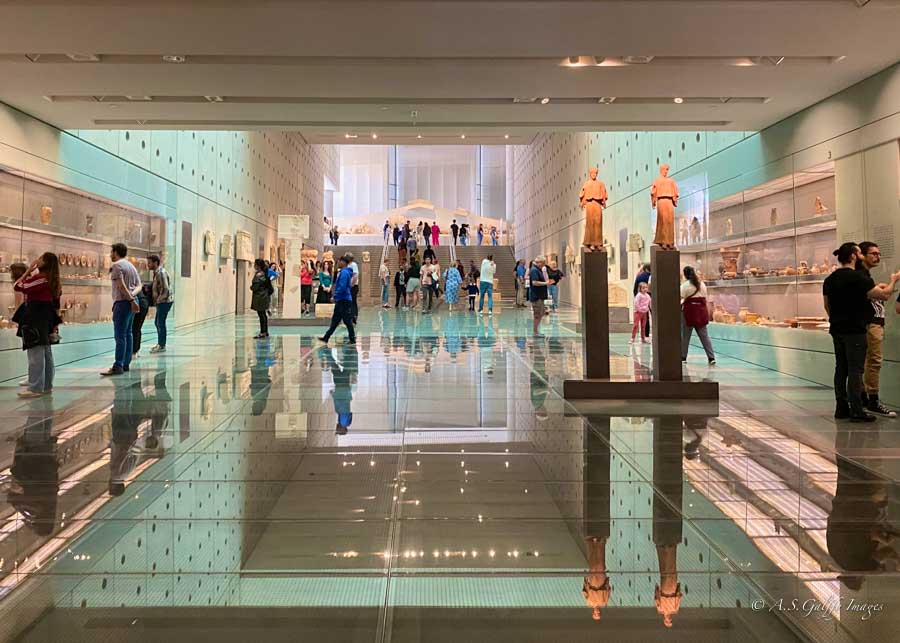
The building itself is fabulous, with its glass top and fabulous views of the Parthenon from its second and third floors! The best time to visit the museum is after touring the Acropolis of Athens.
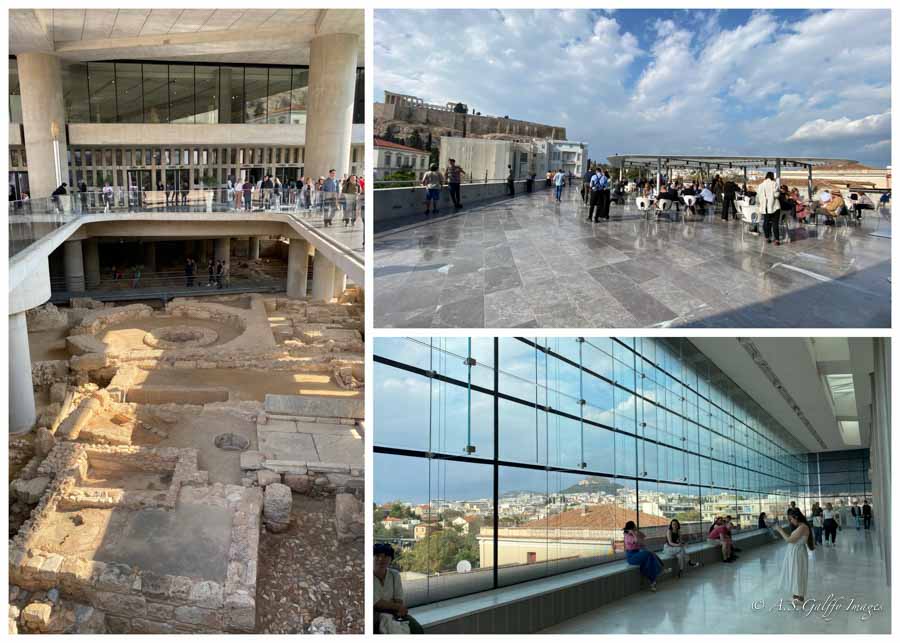
Practical Information
Opening hours are as follows:
Monday to Thursday: 9 am to 5 pm
Friday: 9 am to 10 pm
Saturday & Sunday: 9 am to 8 pm
Admission prices vary by season.
November to March: €10 for adults and €5 for students
April to October: €15 for adults and €10 for students
The Museum’s ticket is independent from the ticket to the Acropolis and other associated archaeological sites, therefore it’s NOT included in the Athens Combo Ticket. You can skip the line by buying the ticket in advance.
3. Ancient Agora & Temple of Hephaestus
The Ancient Agora was mostly a place of political and social gatherings. Not to be confused with the much smaller Roman Agora, which is just a few minutes walk away. The Ancient Agora was where the Athenians would meet to discuss politics and their quotidian lives.
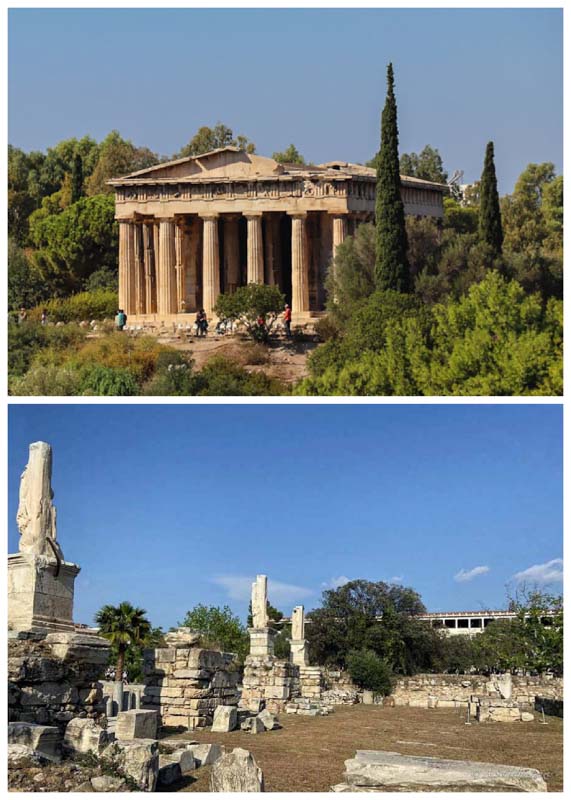
Excavations of the Agora took place relatively recently, between 1859 and 1912. But to everybody’s surprise, a great deal more was discovered during the following years, when they began installing the railway tracks.
Temple of Hephaestus
One of the best preserved ruins in the Ancient Agora is the Temple of Hephaestus. In fact, this structure is famous for being the world’s best-preserved ancient Greek temple.
Practical Information
Ancient Agora is open every day between 8 am and 8 pm.
The site is included with the Athens Combo Ticket. Otherwise, admission costs €10 for adults and €5 for students.
4. Roman Agora
The Roman Agora, which is located on the northern side of the Acropolis, is a relatively small site built by the first Roman Emperor Augustus.
During ancient times the Agora was home to the central market, which had been moved from the next-door Ancient Agora. The market was surrounded by marble colonnades, while the patio was completely covered in marble.
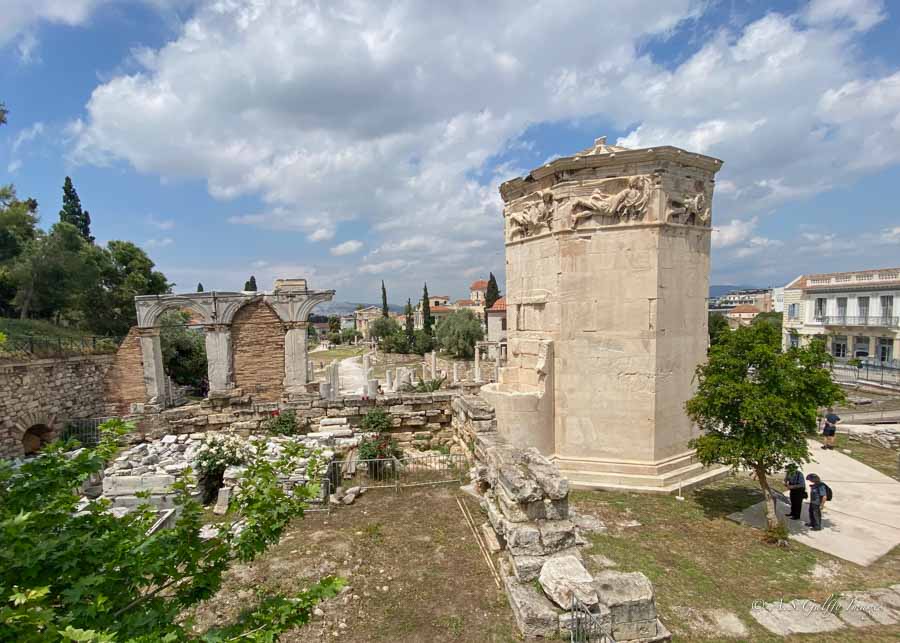
Today only a small portion of the columns are still standing and the remains of a public latrine. The only structure left intact is “Tower of the Winds” which was initially a sundial. During the 6th century the tower was transformed into a chapel, which explains its good preservation.
Practical Information
Opening hours are 8 am to 5 pm daily.
Admission prices are €10 for adults and €5 for students, but with the Athens Combo Ticket, admission is included.
5. Hadrian’s Library
Commissioned by Emperor Hadrian in 132 AD, Hadrian’s Library was once an imposing building that had several reading rooms, a conference hall and an inner courtyard. The library was surrounded by a gallery decorated with one hundred columns.
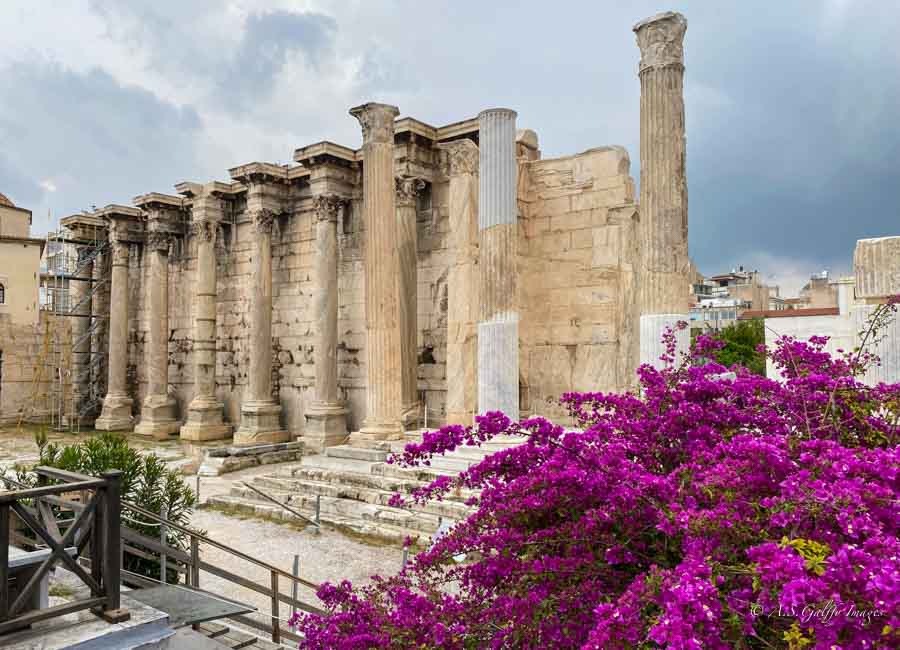
Although it’s not in a very good shape, you can still get an idea of how grandiose the building must have been in its days of glory.
Practical Information
The entrance is next to Monastiraki Square. The library is open every day from 8 am to 8 pm.
Admission fee is €6 for adults and €3 for children. However, the site is free with the Athens Combo Ticket.
6. Temple of Olympian Zeus
The Temple of Olympian Zeus was once an impressive structure made entirely of white marble. The temple took almost 700 years to built. The construction ended in 132 AC, under the Roman Emperor Hadrian. At the completion of the impressive temple the Emperor commissioned two statues for it: one of Zeus, made of gold, and one of himself, made of marble.
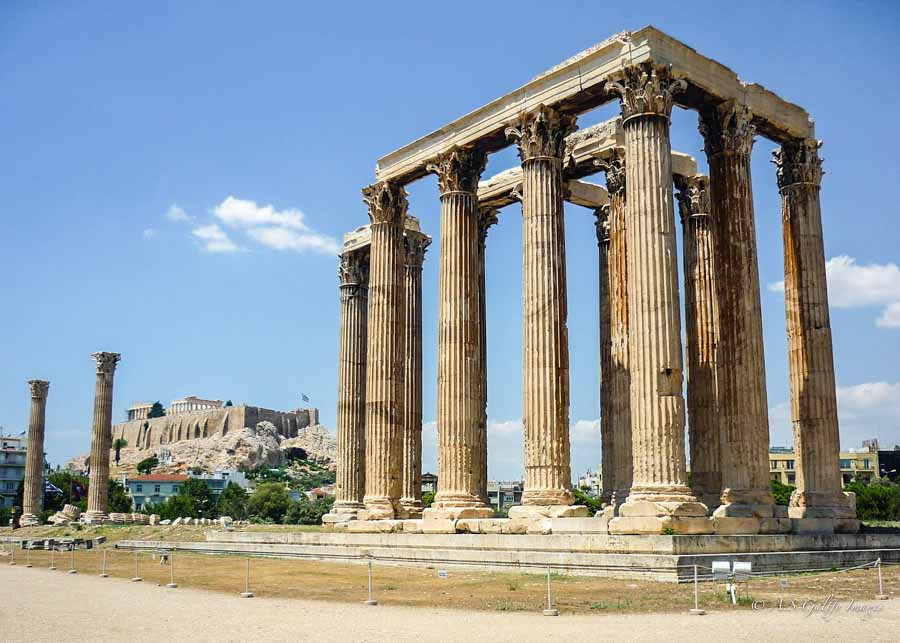
In the Middle Ages an earthquake destroyed most of the temple, so very little of it remains today.
Practical Information
The Temple is open daily from 8 am until 3 pm.
The Temple of Olympian Zeus is one of the sites included in the Athens Combo Ticket. Without the combo ticket, admission costs €12 for adults and €6 for children.
7. Hadrian’s Arch
On the northeast corner of the Temple of Olympian Zeus is Hadrian’s Arch. This monumental gateway was built in honor of the Roman emperor Hadrian. And since Hadrian had become an Athenian citizen nearly two decades before the monument was built, the inscriptions on the arch honor him as an Athenian rather than as the Roman emperor.
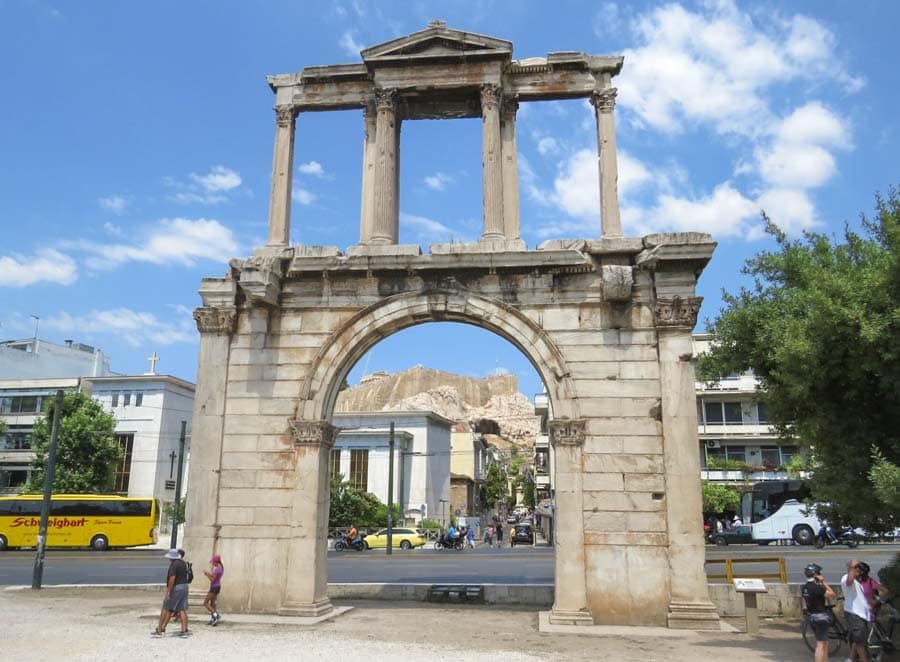
Hadrian’s Arch stands at the edge of a wide, busy road in Plaka and is one of the few ruins in Athens that doesn’t charge admission to visit.
8. Athens National Archeological Museum
The National Archaeological Museum in Athens is the largest and most important museum in Greece. The museum houses artifacts from many archaeological sites around the country. There are collections from Ancient Greece as well as exhibits from other periods in history including the Egyptians, Romans and a collection of Cypriot antiquities.
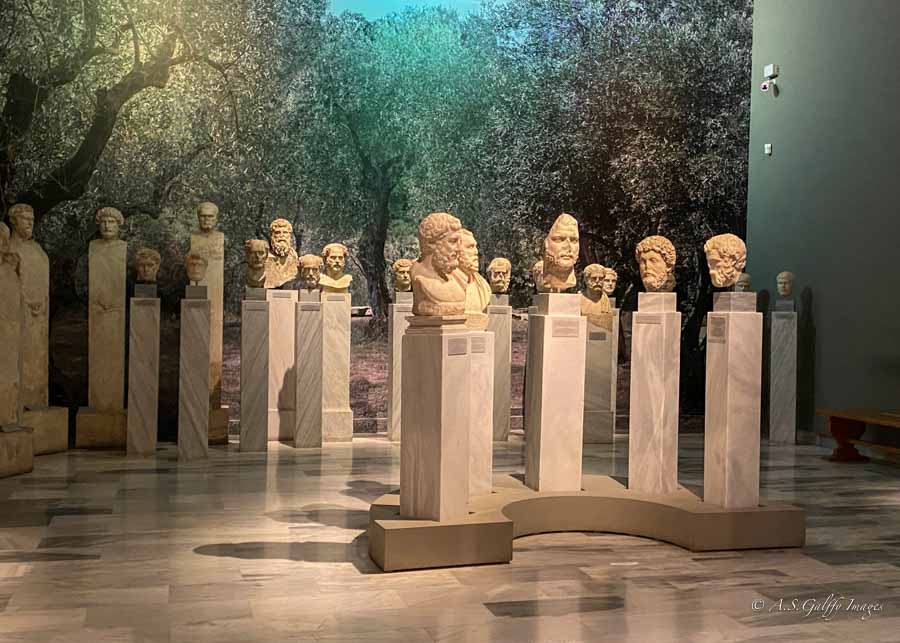
The museum is truly worth visiting and extremely vast, but if you have less than 3 days in Athens you might not have time for it, which would be a shame!
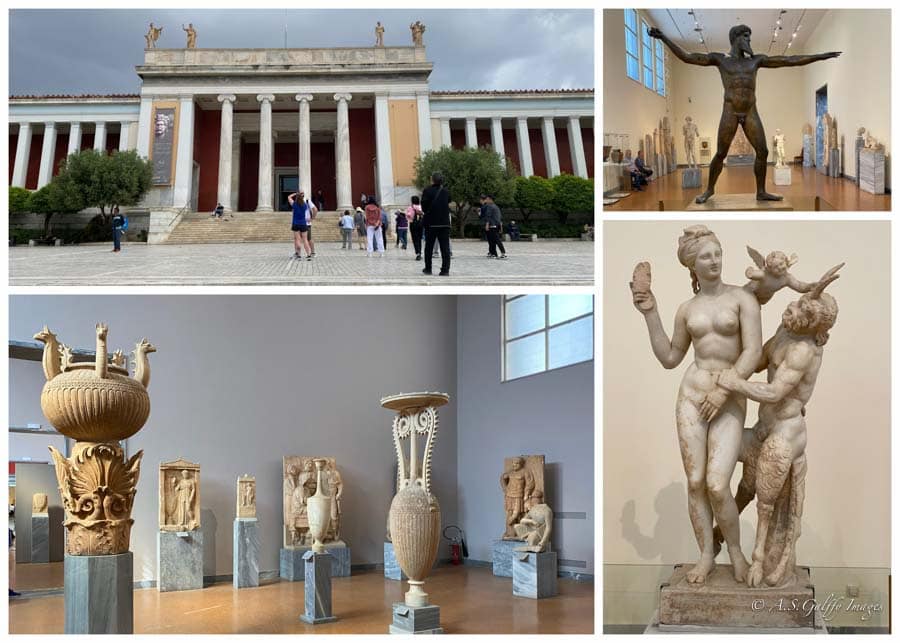
Practical Information
The Museum is open Wednesday till Monday between 8:30 am and 3:30 pm and on Tuesday from 1 pm to 8 pm.
Admission prices are €12 for adults and €6 for students.
9. Karameikos Cemetery
Karameikos is one of the least visited sites in Athens, despite being an important archeological site. In antiquity, this was one of the largest and most important cemeteries in Greece. The cemetery holds a vast collection of tombstones and funerary sculptures.
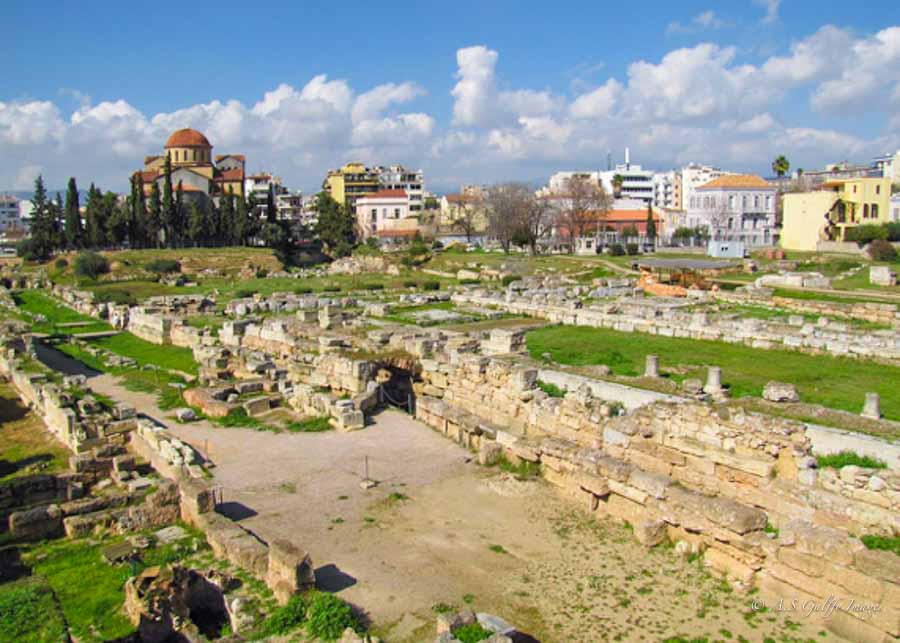
It is located northwest at the end of Ermou Street, just a short walk from Monastiraki Square and the Ancient Agora. As you walk down the ancient path lined with tombs you can learn the stories of its inhabitants and see many impressive tombstones.
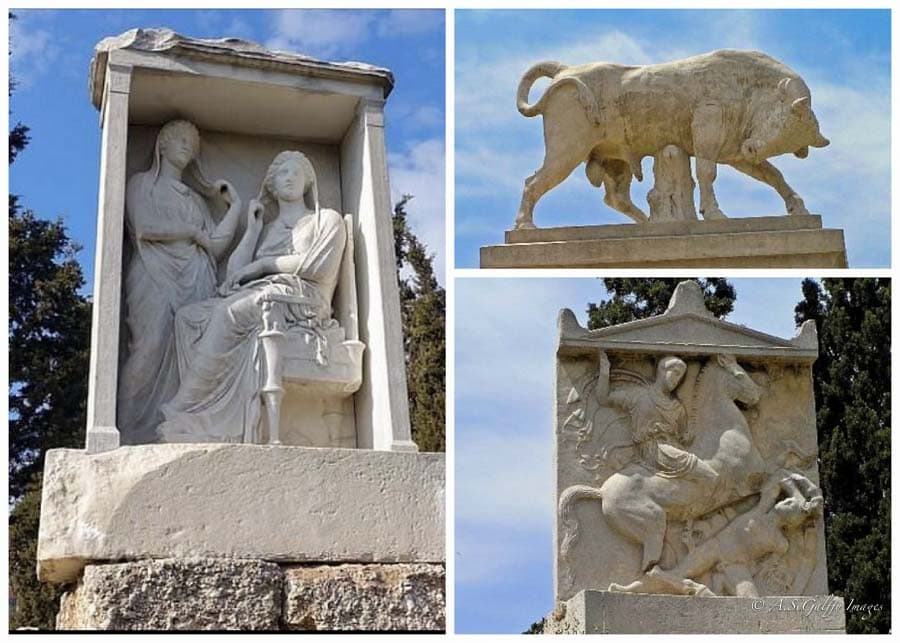
There are many beautiful sculptures the cemetery as well, like the one of the two sisters Pamphili and Demetria, or the the imposing marble bull that crowns the tomb of a prominent Athenian citizen.
On your way out, you can also visit the small museum which has an interesting exhibition of sculptures and pottery.
Practical Information
Karameikos cemetery is open Monday – Sunday, from 8 am to 8 pm. Admission is €8 for adults and €4 for students. Admission is free with the Athens Combo Ticket.
10. Lycabettus Hill
If you want to see the best views in Athens you should walk or take the funicular tramway to the top of Lycabettus Hill. On a clear day you can see the Saronic Gulf and the surrounding mountains from up here.
We visited the hill near dusk, on a clear day, when the views were absolutely breathtaking! Unfortunately, when the weather is nice there are also many people around.
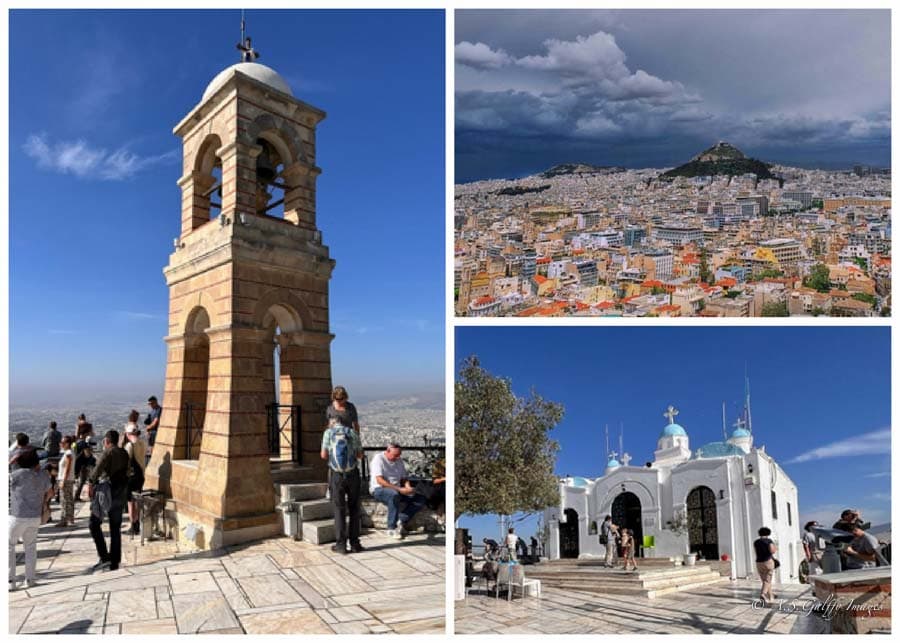
At the top of Lycabettus Hill you can see the Chapel of St. George –a small whitewashed Orthodox church built in the 19th century– and a monument dedicated to the heroes of the Greek War of Independence (1821-1832). There are also a couple of very nice restaurants worth checking out if you want to enjoy lunch or dinner with a view.
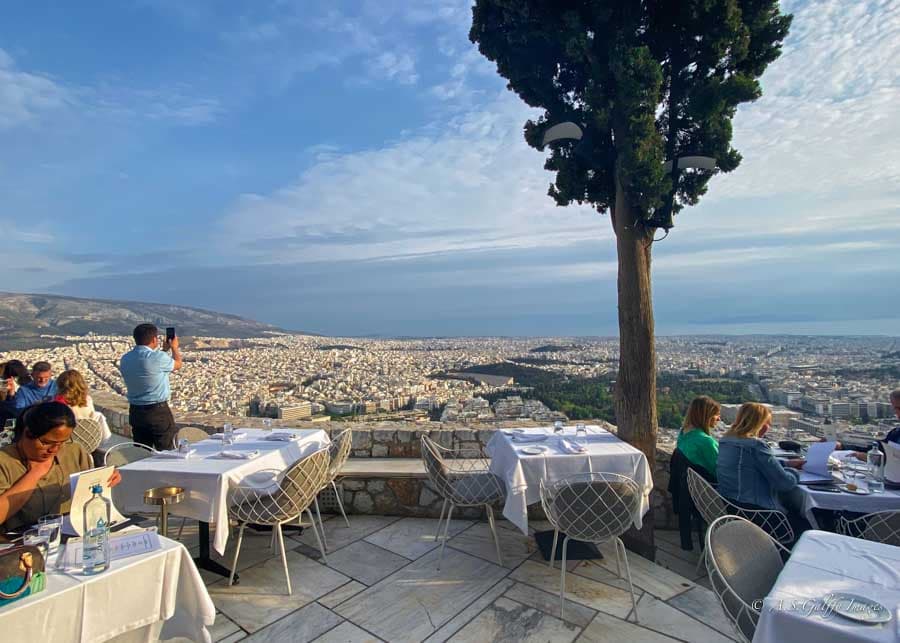
Practical Information
The funicular to Lycabettus Hill runs every day from 9 am to 1:30 am, departing every 30 minutes. Admission prices are: €7 for adults and €3.50 for children.
11. Panathenaic Stadium
The Panathenaic Stadium is a very impressive place to visit, considering that it was the site of the first modern Olympic Games in 1896. This is also where the annual Athens Marathon ends.
The Stadium which dates back to the 4th century B.C. is made entirely of white marble. Hence its nickname, Kallimarmaro, which in means “beautiful marble”.
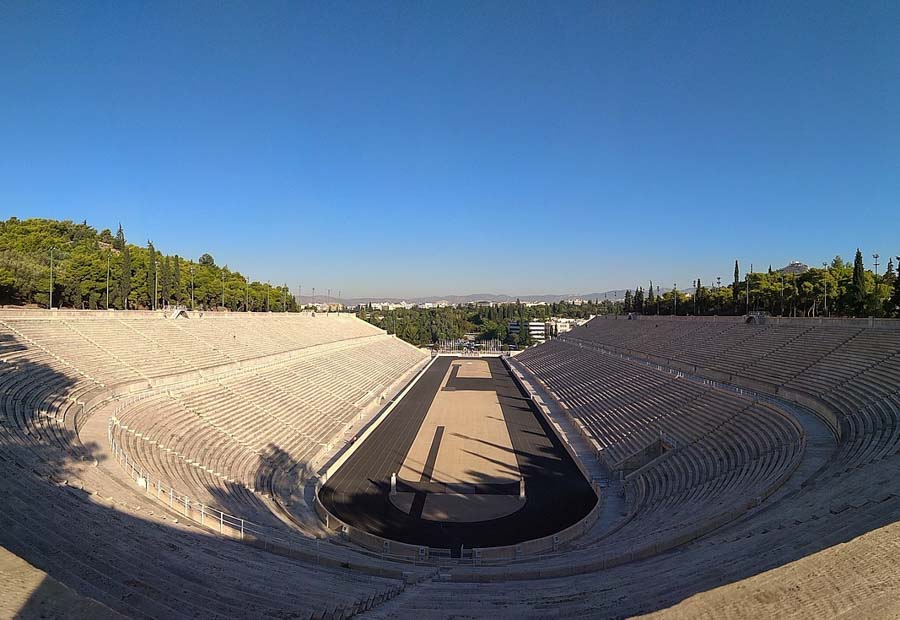
Practical Information
The admission fee is a bit steep (€10/person), but if you have the time and the money it’s worth going in. There are a couple of hours in the morning designated for morning jogs. So of you feel like running in the footsteps of former Olympians, here is your chance!
12. Plaka & Anafiotika Neighborhoods
If you are looking for a romantic place to stroll in Athens, head over to the Mnisikleous Street in Plaka. The street is a long set of stairs lined with rustic restaurants and plenty of vegetation. Although the restaurants vary in quality, the atmosphere here is hard to beat.
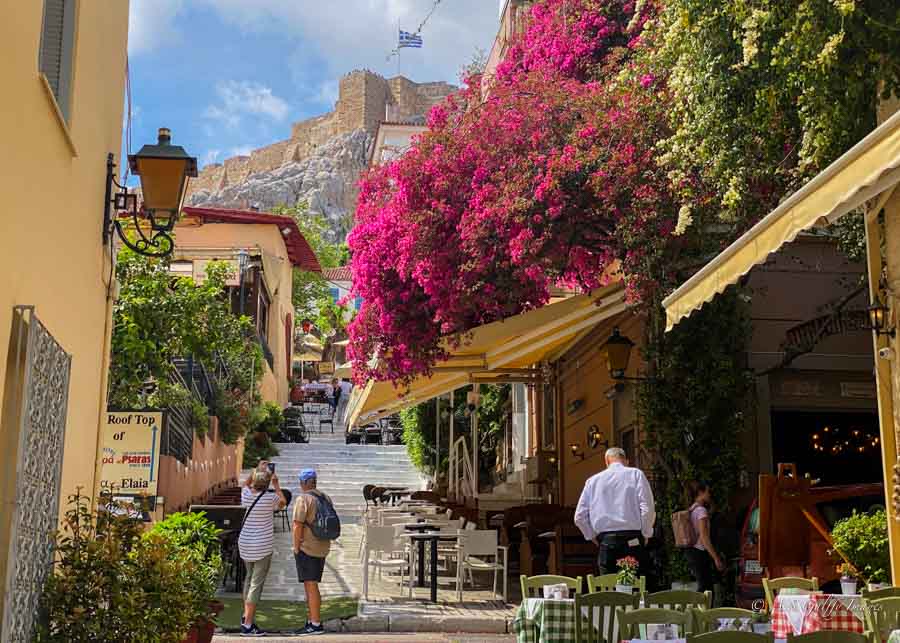
Plaka draws big crowds, especially in the evenings, but it’s a nice neighborhood to stroll just the same. It’s also a good place to see street art in Athens.
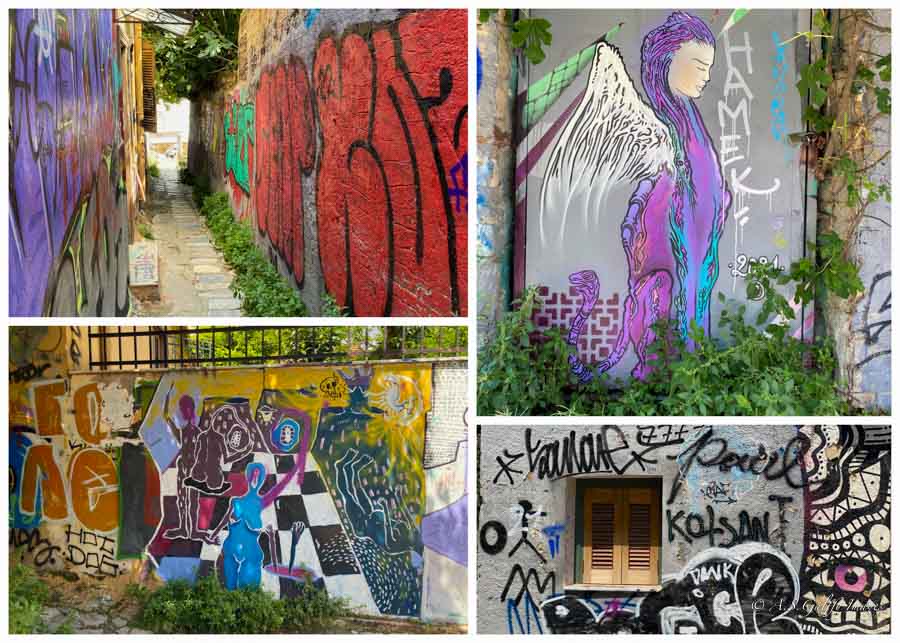
Anafiotika
Anafiotika is basically a small part of Plaka district, located at the base of the Acropolis. You may easily walk in Anafiotika without even realizing it’s a different neighborhood from Plaka. The area is very small and includes only of a handful of narrow alleys with white concrete huts and picturesque taverns.
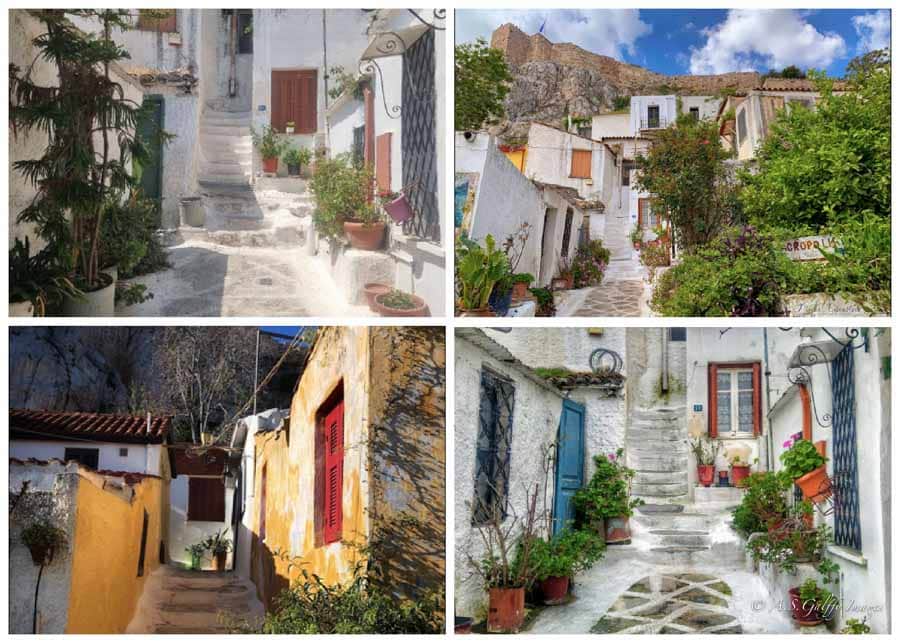
Anafiotika was built in the 1800s by islanders who came to Athens to assist in building the city. Walking the peaceful and quiet alleys makes you feel like you are on the Cyclades, rather than in Athens.
13. Monastiráki Square
Named after the tiny monastery church at its center, Monastiraki Square is a lively spot that you’ll be passed through quite a few times during your 3 days in Athens. This is one of Athens’ liveliest neighborhoods – a mix of history, where on one hand you have Greek and Roman ruins, an Ottoman Mosque and an Orthodox monastery, and on the other hand bars, restaurants, and souvenir shops.
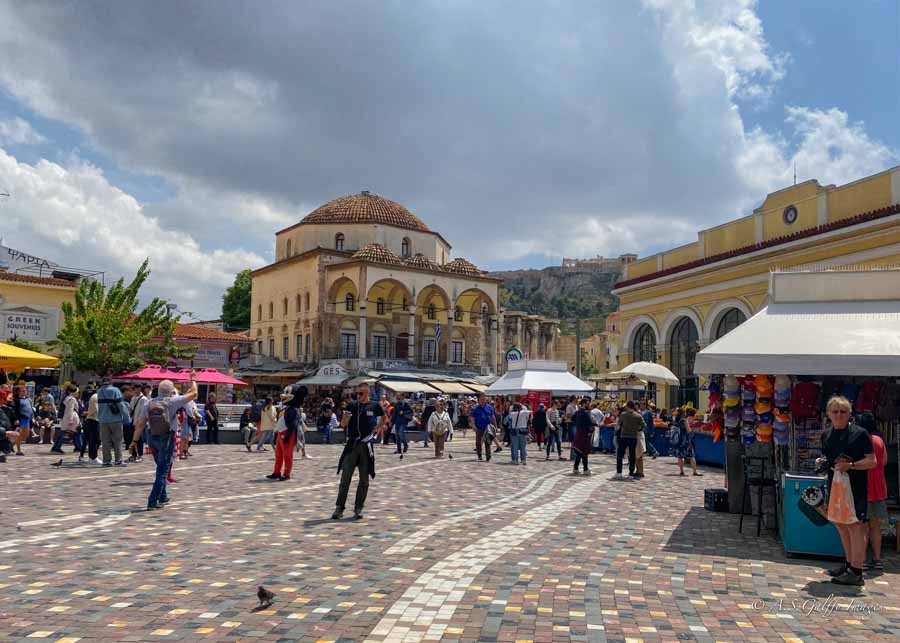
The area is a network of pedestrian streets full of souvenir shops that surround the remains of both the Greek and Roman agoras. Given its proximity to the two agoras, Monastiraki has probably always been a shopping hub and it’s no different today.
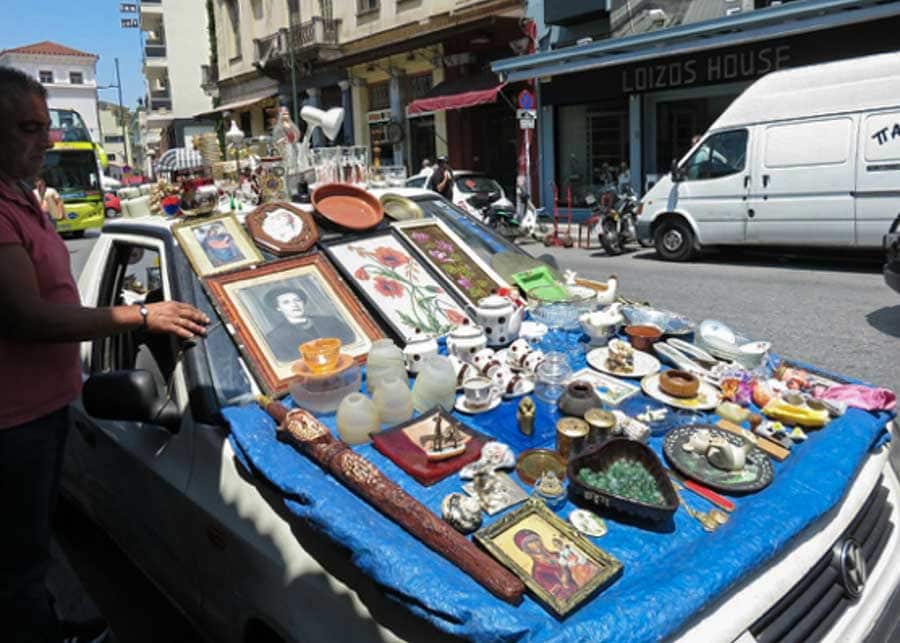
Next to the metro station you’ll find the official Flea Market, while the streets around the market are full of souvenir shops.
14. Church of Panagia Kapnikarea
Panagia Kapnikarea is one of the oldest churches in Athens. The church is located in the outskirts of the Plaka neighborhood, in the center of a busy shopping area. Thousands of people walk by it each day without paying too much attention to this jewel.
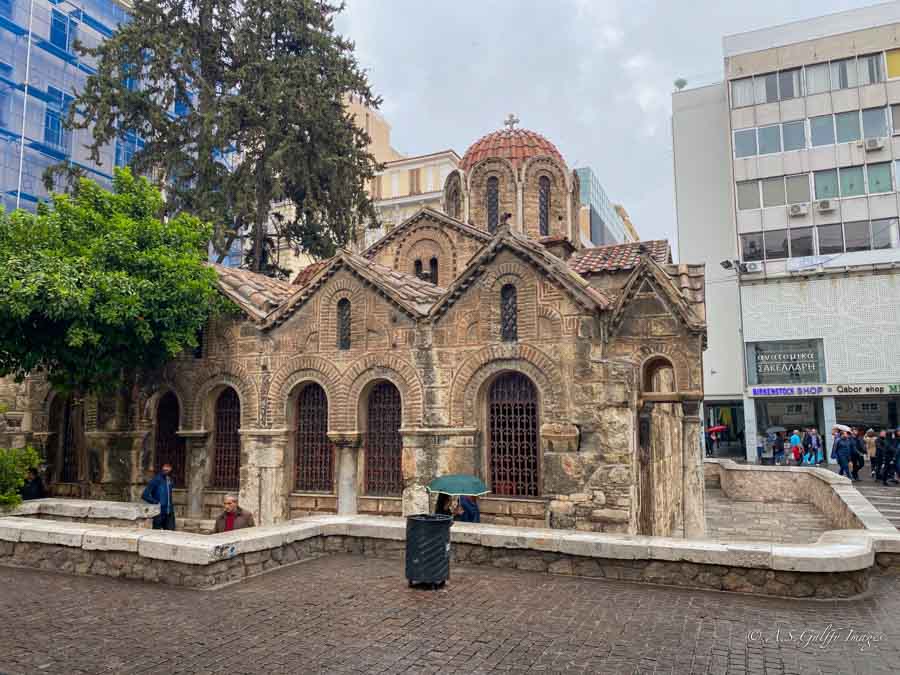
According to the records, Panagia Kapnikarea was built in the early 11th century (around 1050) on the site of an ancient temple that was dedicated either to goddess Athena. But what makes it special is the architectural design, which is very special.
The church has three parts: the main church, a chapel and an exo-narthex. It also has many beautiful Byzantine icons and mosaics.
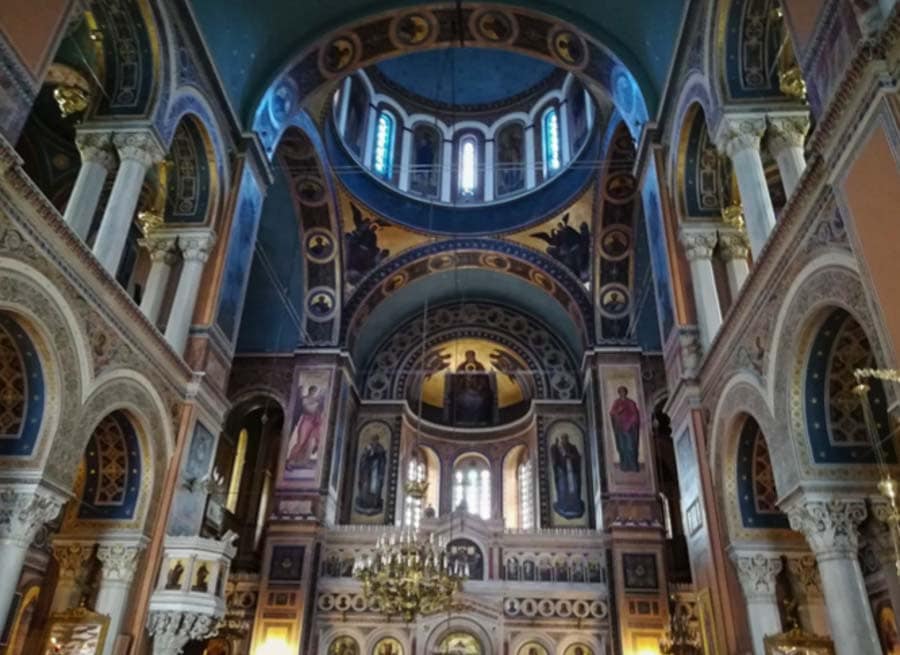
The church of Panagia Kapnikarea has an interesting story. In the 19th century, during the reign of King Otto, the authorities decided to demolish it, as the King’s architect failed to include it in his urban designs. In the end, it was the intervention of King Ludwig of Bavaria that saved the church. Admission to the church is free.
READ NEXT: The 5 Most Important Sites to Visit in Nafplio, Greece
More Than 3 Days in Athens?
If you have more time in Athens, I suggest visiting some of the museums which we haven’t covered in this 3 day itinerary. One of the museums we would have like to visit is the Byzantine and Christian Museum which houses rare collections scriptures, frescoes, pottery, fabrics and manuscripts.
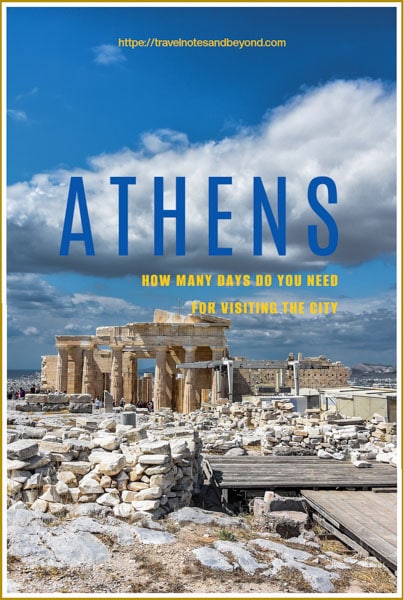

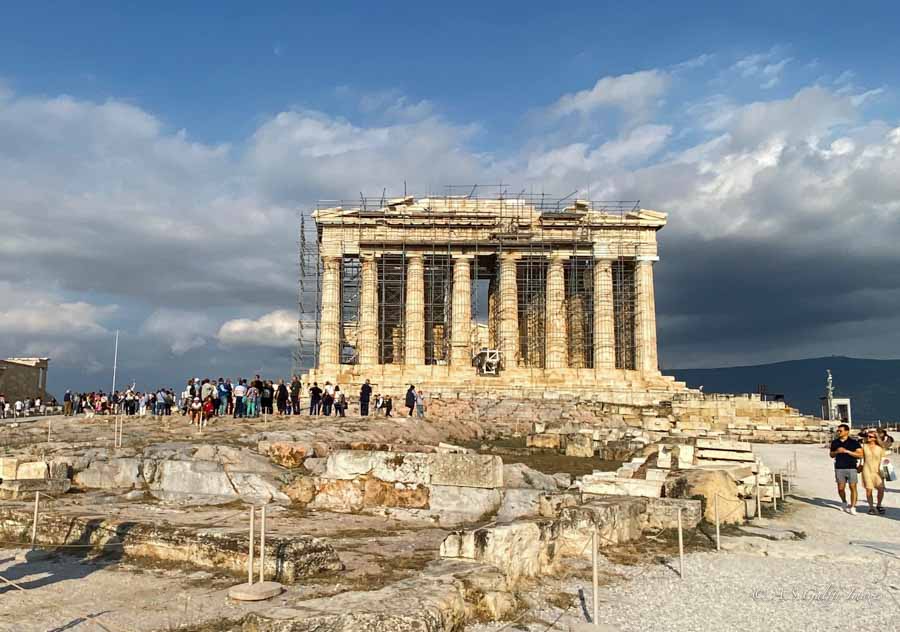
 Peloponnese Itinerary – an Epic Road Trip Through Ancient Greece
Peloponnese Itinerary – an Epic Road Trip Through Ancient Greece


